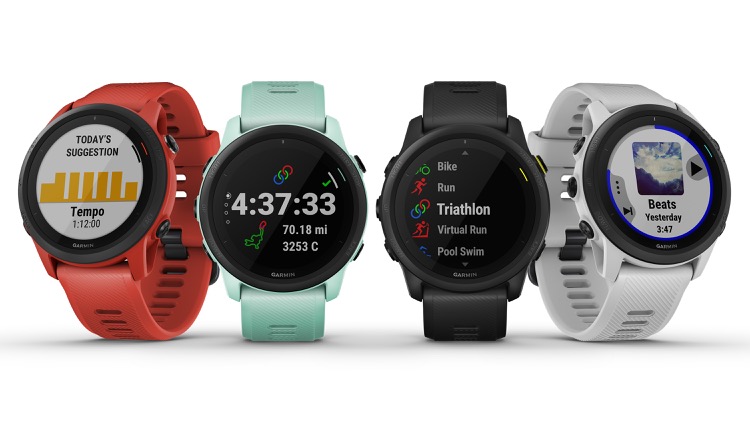 Our reviews are 100% organic. We do not accept payment for reviews or bundle with advertising budgets. In most cases, the brand is providing the product to our reviewers free of charge.
Our reviews are 100% organic. We do not accept payment for reviews or bundle with advertising budgets. In most cases, the brand is providing the product to our reviewers free of charge. Deep dive:
Last September, Garmin released the Forerunner 945, packed with significant updates and a feature profile near the very top of the Garmin inventory. It’s a robust watch for rugged and challenging outings. One of the few drawbacks is the size of the casing, which is rather large for most of our female testers or anyone with a small frame.
The Forerunner 745 comes very close to the feature profile of the 945, but with a noticeably smaller and lighter casing that is ideal for smaller wrists. You compromise a significant amount of battery life with the smaller 745 (by comparison, the 945 has 36 hours of 1-second GPS life), but the 16 hours of 1-second GPS tracking is still enough to get you through all but your longest race efforts. For situations where you need even longer GPS life, you can extend the lifespan to almost 24 hours by switching to GPS only (instead of GPS + GLONASS), turning off phone connectivity, and turning off the backlight function. Another difference between the 745 and 945 is that you lose the ability to download maps onto the watch, which could be a big drawback depending on your typical use, but you can still retain the breadcrumb navigation feature that allows you to retrace your steps back to the start when needed.
Two new features that are unique to the 745 as of this writing (but will be added to the 945 this fall) are track recognition mode and daily suggested workouts. Track Run is a specific activity setting that learns the exact dimensions of your local track so it can give you precise distance measurements with each split – as in, down to the specific meter. To do this, you tell the watch what lane of the track you are running in, and by the time you run a couple of laps, an algorithm has captured the exact dimensions of the track. It’s easy to switch the lane settings back and forth during a workout, for example, if you warm up in an outside lane before doing intervals on the inside lane.
The result of track recognition is a super crisp route map after the fact. The difference between mapped workouts without track mode and those with track mode is pretty amazing. However, there are some quirks to using track mode in that the watch wants you to run only on the lanes of a track – because wandering anywhere else makes it go wonky. That means if you run to the track as a warmup, you’ll get a weird signal, and if you do diagonals across the grass as a cool-down (one of our favorite things), the mapping wants to pull you into a lane of the track.
Another quirk of track mode is that your workout distance is displayed on the watch in meters, even if your watch default setting is miles. The activity is also stored in Garmin Connect in meters, but fortunately is converted to miles by the time it hits Strava. There is one data screen in Track Run mode that has a mileage field, but you can’t otherwise customize that single screen, and you can’t add Imperial mileage to any other data screens in Track Run mode. The good news is that once you’ve mapped your track in Track Run mode, it will remember that location and algorithm for future runs, so you can do other track workouts in regular run mode if you prefer.
The other new run-specific feature is Daily Suggested Workouts, which is an extension of the FirstBeat analytics feature set developed for endurance athletes. (Garmin acquired the FirstBeat company earlier this year.) FirstBeat uses a combination of heart, respiratory, and oxygenation data sensor data along with metrics for stress, sleep, VO2 max, current training status, calories burned and other variables to create more informed decisions about training and recovery. Every time the watch is powered on and connected to the app, it performs a “physio true-up” sync to ensure that the latest data is available for analysis.
Each time you open up an activity setting, the watch gives you a suggested workout based on the FirstBeat calculations. The suggested workout includes an intensity level and duration, pulling your typical physiological and performance data to propose a target pace or HR zone. If you opt to do the suggested workout, the display will guide you to stay in specific pace or heart rate zones with a speedometer-style readout, gives you audio and buzz alerts if you drift too high or too low, and tell you how much time is left in each zone. The suggested workout phase is an added data screen to your normal run mode settings, so you can still scroll through your normal customized screens during the activity.
 If you don’t want to do the suggested workout, you can simply dismiss it and if you don’t want suggestions, the feature is easily deactivated. From a training perspective, the idea is to let go of the reins a bit and possibly identify some blind spots or potential improvements in your overall training approach. We found the suggestions to be pretty intuitive. After hard days we were usually told to take it easy, and after a day off, the watch suggested a threshold or sprint workout. The suggestion algorithm does not take into account your normal weekly training pattern. In other words, it doesn’t learn that you normally do long runs on Saturdays and speedwork on Tuesdays. From a purely physiological standpoint, this approach is better, as it takes a holistic approach to adaptive coaching. So if you slept terribly on Monday night, you may not be recovered enough to do a hard workout on Tuesday. The watch will recognize this and recommend an easier day – which you can then go ahead and ignore if you’re like most stubborn runners.
If you don’t want to do the suggested workout, you can simply dismiss it and if you don’t want suggestions, the feature is easily deactivated. From a training perspective, the idea is to let go of the reins a bit and possibly identify some blind spots or potential improvements in your overall training approach. We found the suggestions to be pretty intuitive. After hard days we were usually told to take it easy, and after a day off, the watch suggested a threshold or sprint workout. The suggestion algorithm does not take into account your normal weekly training pattern. In other words, it doesn’t learn that you normally do long runs on Saturdays and speedwork on Tuesdays. From a purely physiological standpoint, this approach is better, as it takes a holistic approach to adaptive coaching. So if you slept terribly on Monday night, you may not be recovered enough to do a hard workout on Tuesday. The watch will recognize this and recommend an easier day – which you can then go ahead and ignore if you’re like most stubborn runners.
As we mentioned earlier, Track Run and Daily Suggested Workouts will come to the Forerunner 945 in the near future, so these new features on the 745 don’t justify replacing your higher-end model. Rather, the 745 model is ideal for someone who wants a super strong feature set and robust activity tracker with a more affordable price point (as of this writing, the 745 cost is $100 less than the 945), or anyone who prefers a sleek and lower profile watch that is suitable for the vast majority of your training and racing needs.
The Garmin Forerunner 745 is now available at www.garmin.com as well as multiple retailers.
Basic summary: The successor to Garmin’s multi-sport focused Forerunner 735XT, expanding the functionality of that model extensively, and closely approaching the feature profile of the higher-end Forerunner 945. In comparison to the 945, the Forerunner 745 has a smaller casing, minimal navigation features and lower battery life, but has a more affordable price point. The 745 comes with a few new workout features that aren’t currently included on the 945, but those will migrate to the 945 later this fall.
MSRP: $499
- Weight: 47g
- Dimensions (mm): 43.8 x 43.8 x 13.3
- Display size: 30.4mm diameter
- Display resolution: 240 x 240 pixels, multi-color
- Lens material: Corning Gorilla Glass DX
- Battery life:
- Smartwatch mode: Up to 7 days
- GPS mode with music: Up to 6 hours
- GPS mode without music: Up to 16 hours
- UltraTrac mode: Up to 21 hours
- Water rating: 5ATM
- Multiple alarm and alert capacity
- Silent/vibrating alerts
- 24/7 continuous HR monitoring with Elevate Optical HR sensor
- Continuous pulse oximeter (not functional during activity)
- Full health monitoring and sleep tracking metrics
- Menstrual cycle tracking
- Music storage (up to 500 songs) and playback controls at wrist
- Contactless NFC payments
Training and Navigation Features:
- GPS tracking through GLONASS and Galileo systems
- Daily suggested workouts
- Track mode mapping
- Barometric altimeter
- Compass, gyroscope, accelerometer, thermometer
- Altitude and heat acclimation
- Incident detection for emergency notification
- ClimbPro for real-time climb details during activity
- Training load, stress tracking and body battery
- Fitness age
- Race predictor
- Four data screens available during an activity
- Multiple screen customization options
Connectivity Features:
- Functionality through Garmin Connect app or desktop
- Data screens customized at wrist or through app
- Connect IQ downloadable watch faces, data fields, widgets, apps
- Automatic data transfer to Strava and other third party apps
- Phone and text notifications and response through watch during activity (Android only) and at rest
- Garmin Pay compatible








